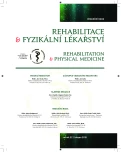-
Medical journals
- Career
Efficacy Comparison of Individual and Group Physiotherapy in Patients with Urinary Incontinence
Authors: R. Holaňová 1; K. Hegedüsová 1; M. Gärtner 2; J. Krhut 3
Authors‘ workplace: Klinika léčebné rehabilitace FN Ostrava, přednostka MUDr. I. Chmelová, Ph. D. 1; Porodnicko-gynekologická klinika FN Ostrava, přednosta doc. . MUDr. V. Unzeitig, CSc. 2; Urologické oddělení FN Ostrava, přednosta doc. MUDr. J. Krhut, Ph. D. 3
Published in: Rehabil. fyz. Lék., 22, 2015, No. 1, pp. 22-25.
Category: Original Papers
Overview
This paper compares the effect of individual and group physiotherapy in patient with stress and mixed urinary incontinence. Total evaluated 56 women (28 women in the group individually guided physiotherapy, 28 women in the group led by a group of physiotherapy). The duration of therapy was six months with the total number of visits ninth. The efficacy of therapy was evaluated using three objective and two subjective parameters. We observed improvement in both objective and subjective parameters in both groups during therapy. The difference in improvement in subjective parameters was statistically significantly higher in patients treated individually.
Keywords:
urinary incontinence, individual physiotherapy, group physiotherapy
Sources
1. ABRAMS, P., CARDOZZO, L., KHOURY, S., WEIN, A.: Incontinence. 5-th International Consultation on Incontinence. Paris, 2013. ISBN: 978-9953-493-21-3.
2. DE OLIVEIRA CAMARGO, F., RODRIGUEZ, A., ARRUDA, R., FEREIRA SARTOTRI, A., GIRAO, M., CASTRO, R.: Pelvic floor muscle training in female stress urinary incontinence: comparison between group training and individual treatment using PERFECT assessment scheme. Int. Urogynecol. J., 2009, č. 20, s. 1455-1462. ISSN 0937-3462.
3. GHONIEM, G., VAN LEEUWEN, J., ELSER, D., FREEMAN, R., ZHAO, Y., YALCIN, I., BUMP, R.: Duloxetine/Pelvic Floor Muscle Training Clinical Trial Group.: A randomized controlled trial of duloxetine alone, pelvic floor muscle training alone, combined treatment and no active treatment in women with stress urinary incontinence. J. Urol., roč. 173, 2005, s. 1647-1653. ISSN 0022-5347.
4. HINTZE, J.: NCSS and PASS, Number Crundur Statistical Systems, Kaysville, Utah, US, 2001 (www.NCSS.com).
5. HUNSKAAR, S., LOSE, G., SYKES, D., VOSS, S.: The prevalence of urinary incontinence in women in four European countries. BJU Int., roč. 93, 2004, č. 3, s. 324-330.
6. KRHUT, J., HOLAŇOVÁ, R., MUROŇOVÁ, I.: „Ostravský koncept“ fyzioterapie v léčbě močové inkontinence. Rehabil. fyz. Lék., roč. 12, 2005, s. 122-128. ISSN 1211 - 2658.
7. PEREIRA V., CORREIA, G., DRIUSSO, P.: Individual and group pelvic floor muscle training versus no treatment in female stress urinary incontinence: a randomized controlled pilot study. EJOG, roč. 159, 2011, s. 465-471. ISSN 0301-2115.
8. WAGNER, T., PATRICK, D., BAVENDAM, T., MARTIN, M., BUESCHING, D.: Quality of life of persons with urinary incontinence: development of a new measure. Urology, roč. 47, 1996, s. 67-72. ISSN 0090-4295.
Labels
Physiotherapist, university degree Rehabilitation Sports medicine
Article was published inRehabilitation & Physical Medicine

2015 Issue 1-
All articles in this issue
- Sole Pressure Sore in Diagnostics of Functional Foot Types
- Heel Pain in the Heel Region
- Canis Therapy and Its Use in Rehabilitation
- Efficacy Comparison of Individual and Group Physiotherapy in Patients with Urinary Incontinence
- Problems in Using Surface Electromyography – Remarks On Selected Aspects of Application in Therapeutic Rehabilitation
- Influence of Epicondylar Brace On Viscoelastic Properties of Soft Tissues in Diagnostics of Tennis Elbow
- Occupational Therapy
- Rehabilitation & Physical Medicine
- Journal archive
- Current issue
- Online only
- About the journal
Most read in this issue- Occupational Therapy
- Heel Pain in the Heel Region
- Sole Pressure Sore in Diagnostics of Functional Foot Types
- Canis Therapy and Its Use in Rehabilitation
Login#ADS_BOTTOM_SCRIPTS#Forgotten passwordEnter the email address that you registered with. We will send you instructions on how to set a new password.
- Career

